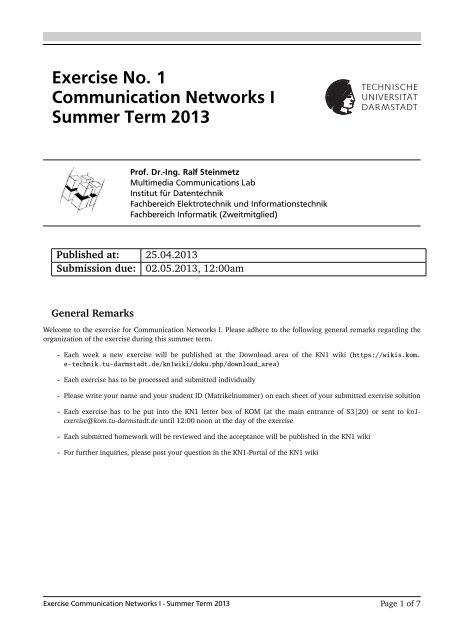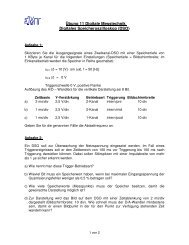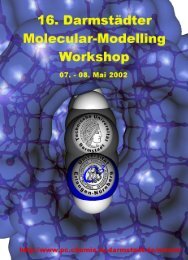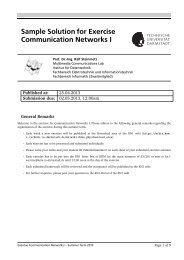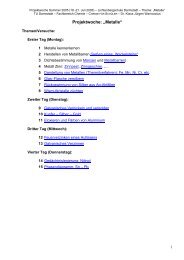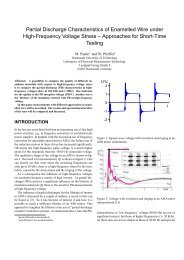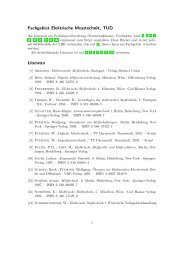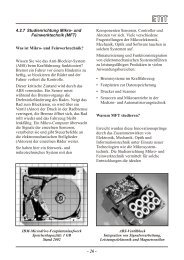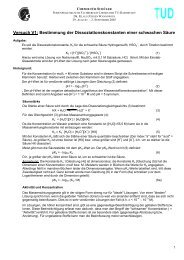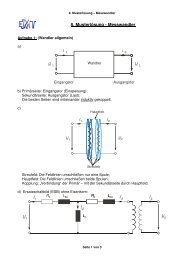Exercise No. 1 Communication Networks I Summer Term 2013
Exercise No. 1 Communication Networks I Summer Term 2013
Exercise No. 1 Communication Networks I Summer Term 2013
You also want an ePaper? Increase the reach of your titles
YUMPU automatically turns print PDFs into web optimized ePapers that Google loves.
<strong>Exercise</strong> <strong>No</strong>. 1<br />
<strong>Communication</strong> <strong>Networks</strong> I<br />
<strong>Summer</strong> <strong>Term</strong> <strong>2013</strong><br />
Prof. Dr.-Ing. Ralf Steinmetz<br />
Multimedia <strong>Communication</strong>s Lab<br />
Institut für Datentechnik<br />
Fachbereich Elektrotechnik und Informationstechnik<br />
Fachbereich Informatik (Zweitmitglied)<br />
Published at: 25.04.<strong>2013</strong><br />
Submission due: 02.05.<strong>2013</strong>, 12:00am<br />
General Remarks<br />
Welcome to the exercise for <strong>Communication</strong> <strong>Networks</strong> I. Please adhere to the following general remarks regarding the<br />
organization of the exercise during this summer term.<br />
- Each week a new exercise will be published at the Download area of the KN1 wiki (https://wikis.kom.<br />
e-technik.tu-darmstadt.de/kn1wiki/doku.php/download_area)<br />
- Each exercise has to be processed and submitted individually<br />
- Please write your name and your student ID (Matrikelnummer) on each sheet of your submitted exercise solution<br />
- Each exercise has to be put into the KN1 letter box of KOM (at the main entrance of S3|20) or sent to kn1-<br />
exercise@kom.tu-darmstadt.de until 12:00 noon at the day of the exercise<br />
- Each submitted homework will be reviewed and the acceptance will be published in the KN1 wiki<br />
- For further inquiries, please post your question in the KN1-Portal of the KN1 wiki<br />
<strong>Exercise</strong> <strong>Communication</strong> <strong>Networks</strong> I - <strong>Summer</strong> <strong>Term</strong> <strong>2013</strong> Page 1 of 7
Problem 1 - Multiple Choice<br />
a) Why does the Data Link Layer append a trailer to frames<br />
A) This is due to the router configuration.<br />
B) The Data Link Layer runs always in reverse mode.<br />
C) Defined by IP.<br />
D) The Data Link Layer only appends a header, but never a trailer.<br />
E) This way the checksum for error correction can be done “on the fly”.<br />
b) Which layer does IP belong to<br />
A) Physical Layer<br />
B) Data Link Layer<br />
C) Network Layer<br />
D) Transport Layer<br />
E) Application Layer<br />
c) Which is not a layer in the ISO-OSI model<br />
A) Security Layer<br />
B) Physical Layer<br />
C) Data Link Layer<br />
D) Network Layer<br />
E) Transport Layer<br />
d) Which of the following statements is true<br />
I) In a well designed system, the higher layer does not have to worry about the implementation details of lower<br />
layers<br />
II) A layer offers a service to the next higher layer<br />
III) Two entities of the same layer handle a protocol<br />
Select the correct option:<br />
A) Only I<br />
B) I and II<br />
C) I, II and III<br />
D) Only II<br />
E) II and III<br />
e) Which of these encoding mechanisms are not “self-clocking”<br />
I) Manchester encoding<br />
II) Differential Manchester encoding<br />
III) Binary encoding<br />
IV) <strong>No</strong>nreturn to zero<br />
V) Return to zero<br />
Select the correct option:<br />
A) I, II and III<br />
B) I, II and V<br />
C) II, IV and V<br />
D) III and IV<br />
E) IV and V<br />
<strong>Exercise</strong> <strong>Communication</strong> <strong>Networks</strong> I - <strong>Summer</strong> <strong>Term</strong> <strong>2013</strong> Page 2 of 7
f) What is the technique of merging inputs of many links onto one link called<br />
A) Digitalizing<br />
B) Multiplexing<br />
C) Transmitting<br />
D) Tunneling<br />
E) Routing<br />
<strong>Exercise</strong> <strong>Communication</strong> <strong>Networks</strong> I - <strong>Summer</strong> <strong>Term</strong> <strong>2013</strong> Page 3 of 7
Problem 2 - <strong>Term</strong>inology<br />
a) Name objectives of communication networks with examples.<br />
b) Explain the terms service and protocol in the context of the layer model.<br />
c) Explain the terms connection-oriented service and connectionless service with examples.<br />
d) Consider the following illustration of a packet. What do you notice<br />
H4 H3 H5 Data<br />
H: Header-Data<br />
e) Characterize a communication network in demarcation to<br />
- Master/Slave configuration<br />
- Multiprocessor system<br />
- Distributed system<br />
f) The president of a company designing cellular phones wants to start a joint venture with a company designing<br />
microchips. He tells his legal department to look into it who in turn asks engineering for help. As a result, the<br />
chief engineer calls his counterpart of the other company to discuss the technical details of the project. The<br />
engineers then report back to the legal department, which then confer by telephone to arrange the legal<br />
aspects. Finally, the two presidents discuss the finances of the deal. Is this an example of a multilayer protocol<br />
in the sense of the OSI model<br />
g) A system has a n-layer protocol hierachy. Applications generate messages of length M bytes. What fraction of<br />
the network bandwidth is filled with headers, if at each of the layers a h-byte header is added<br />
h) What is the Interplanetary Internet Special Interest Group<br />
<strong>Exercise</strong> <strong>Communication</strong> <strong>Networks</strong> I - <strong>Summer</strong> <strong>Term</strong> <strong>2013</strong> Page 4 of 7
Problem 3 - Layer Model<br />
a) Describe the Layers of the ISO-OSI Model and their function.<br />
b) What are the differences of the ISO-OSI Model to the TCP/IP Model<br />
<strong>Exercise</strong> <strong>Communication</strong> <strong>Networks</strong> I - <strong>Summer</strong> <strong>Term</strong> <strong>2013</strong> Page 5 of 7
Problem 4 - Topology<br />
In topology I), 7 routers are interconnected by a binary tree. In topology II) they are interconnected in a ring, and in<br />
topology III) there is link between any two routers.<br />
1<br />
1<br />
1<br />
2<br />
7<br />
2<br />
7<br />
2 3<br />
3<br />
6<br />
3<br />
6<br />
4 5 6 7<br />
I<br />
4 5<br />
II<br />
4 5<br />
III<br />
a) A message is sent via the shortest path. For each topology, what is the average number of hops, assuming<br />
that all router pairs are equally likely The router-host and router-router links are counted as one hop each.<br />
b) The probability for a router being down is p. What is the probability that the path from router 4 to router 7<br />
exists, assuming that neither 4 nor 7 are down.<br />
c) Discuss the advantages and disadvantages of each topology.<br />
<strong>Exercise</strong> <strong>Communication</strong> <strong>Networks</strong> I - <strong>Summer</strong> <strong>Term</strong> <strong>2013</strong> Page 6 of 7
Problem 5 - Physical Layer<br />
a) Transmission of data can be amazing high by using magnetic tapes. However, why is this way of data<br />
transmission unsuitable for a lot of applications<br />
b) For data transmission a three-tier signal is used to transmit the values 0, 1, and 2. Per second 2000 signal<br />
alternations can be realized.<br />
I) How high is the bit rate<br />
II) How high is the baud rate<br />
c) We want to implement data transmission with 1 kbit/s between two systems using Differential Manchester<br />
Encoding. What baud rate do we need<br />
d) In the following figure, the differences between synchronous and asynchronous time multiplexing have to be<br />
shown. Therefore, all the required information have to be depicted. If necessary, a legend should be given.<br />
Three stations A, B and C want to send some data in the order you see at the left. Please draw in the figure<br />
what will be on the line using · · ·<br />
I) synchronous time multiplexing.<br />
II) asynchronous time multiplexing.<br />
I) Synchronous<br />
A1<br />
B1<br />
C1<br />
A2<br />
C2<br />
time<br />
II) Asynchronous<br />
e) Why was the packet transmission technique not chosen for traditional telephone service<br />
<strong>Exercise</strong> <strong>Communication</strong> <strong>Networks</strong> I - <strong>Summer</strong> <strong>Term</strong> <strong>2013</strong> Page 7 of 7


